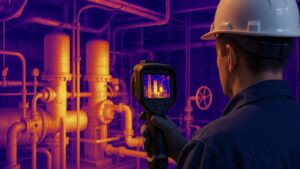Real-time data processing has become more and more in demand as a result of the IoT era. Edge computing has therefore come to be seen as a response to this need. Edge data centers are positioned strategically closer to end users and devices. It maximizes the energy economy and provides low-latency services. Furthermore, the growth of edge data centers offers a unique opportunity to transform the data center industry. It changes the approach to energy saving as the globe strives to lower carbon footprints. So, let’s dive into the role of edge data centers in energy efficiency.
Edge Data Centers: Distributed Architecture: Minimizing Data Transmission Distances
The distributed design of edge data centers is one of their main benefits. These facilities drastically cut down on the distance that data must travel. This is by processing data closer to the source. So, it minimizes the energy consumption involved in data transmission. This localized method reduces the energy needed for long-distance data transport. It also improves speed and responsiveness.
Reduced Network Congestion
Data is processed locally at edge centers. As a result, there is less strain on central data centers and core networks. Furthermore, the decrease in network congestion translates into increased energy efficiency. This is because less energy is needed to maintain and run complex network infrastructure.
Optimized Network Topology
The scattered nature of edge data centers makes a more optimal network structure possible. Moreover, edge facilities can use localized networks. These are designed to meet particular geographical needs in place of a centralized, high-capacity backbone network. This focused strategy reduces wasteful energy use and makes resource allocation more effective.
Edge Data Centers: Compact and Modular Design for Energy Efficiency
Compact and modular designs are common in edge centers, allowing for effective energy use and scalability.
Smaller Footprints, Lower Cooling Demands
Edge centers have far smaller footprints than their bigger, more centralized counterparts. Furthermore, the compact form results in lower cooling requirements. This is Given the smaller surface area and total infrastructure to cool. Moreover, energy efficiency is further improved by the modular design. It enables exact cooling changes based on operating demands.
Efficient Use of Space
Edge data centers’ small size guarantees effective use of available space. These buildings optimize the amount of energy used for lighting, air conditioning, and more. This is by reducing superfluous floor area.
Scalable and Flexible Infrastructure
Scalability and flexibility are key considerations in the construction of edge centers. Furthermore, as demand rises, their modular architecture enables gradual development. It guarantees resource allocation and energy use only when required. So, this scalable method allows for effective resource utilization while minimizing unnecessary overprovisioning.
Modular Components and Hot-Swapping
The modular design of edge centers makes it easier to utilize modular components and perform hot-swapping procedures. This promotes energy efficiency by reducing downtime and related energy expenses. It also enables simple maintenance, upgrades, and replacements without interfering with continuing operations.
Edge Data Centers: Leveraging Renewable Energy Sources
Edge centers’ dispersed architecture offers special chances to use renewable energy sources. As a result, it reduces their environmental effect and improves sustainability.
Localized Renewable Integration
Dispersing edge facilities across multiple regions allows for easier integration of local renewable energy sources. This includes using clean and sustainable power like solar, wind, or geothermal energy for operating edge data centers. It will depend on the unique characteristics of the area.
Microgrids and Energy Storage Solutions
Energy storage systems and microgrid deployment can be advantageous for edge centers. These facilities can achieve a high degree of energy resilience and self-sufficiency. This is by integrating battery storage systems with renewable energy sources. So, this reduces their need for conventional grid infrastructure. It also minimizes energy losses caused by transmission.
Intelligent Energy Management
Intelligent energy management systems can be utilized by edge data centers. It increases the use of renewable sources giving way to real-time decision making. It helps to optimize the usage of energy and reduce the dependence on non-renewable sources. They do this by monitoring energy generation, consumption patterns, and also storage levels.
Edge Data Centers: Innovative Cooling Strategies
The cooling systems in data centers are primarily responsible for their energy usage. Edge facilities are in a good position to implement cutting-edge cooling solutions. These are customized to meet their particular needs because of their distinctive features.
Free Cooling and Liquid Cooling
Edge centers can make better use of free cooling approaches due to their localized deployments and compact architecture. These facilities can reduce or do away with the requirement for energy-intensive mechanical cooling systems. This is by making use of local water supplies or ambient air temperatures. Furthermore, liquid cooling technologies are easier to integrate in edge situations. This is due to their increased efficiency and superior heat dissipation.
Waste Heat Recovery and Reuse
Edge data centers’ small design offers further advantages for recovering and reusing waste heat. IT equipment produces heat that can be collected and used for a variety of purposes. It includes powering absorption chillers or heating buildings. This strategy minimizes waste. It not only lowers the impact on the environment but also increases total energy efficiency.
Adaptive Cooling Strategies
Adaptive cooling techniques that adapt to changing operating circumstances can be used in edge data centers. These facilities can dynamically optimize their cooling systems. This is so that energy is used only when and where it is needed. This is by continually monitoring variables like workload, ambient temperatures, and energy availability.
Efficient Airflow Management
Another crucial component of optimizing cooling energy use in edge centers is effective airflow control. These facilities can minimize energy losses related to poor airflow. They can also increase overall cooling efficiency. This is by carefully planning and executing airflow management solutions, such as hot aisle/cold aisle arrangements.
Edge Data Centers: Edge Analytics and Workload Optimization
Intelligent data processing and edge decision-making are integral components of edge computing. It goes beyond physical infrastructure.
Edge Analytics for Energy Optimization
Real-time energy usage optimization is possible for edge centers with the use of edge analytics capabilities. Energy can be used effectively and efficiently. This is by using advanced algorithms and machine learning models. It analyzes data streams, spot trends, and also decides on resource allocation, cooling tactics, and task distribution.
Workload Distribution and Consolidation
Edge computing architectures let you move tasks around different edge sites easily. They can send tasks to the most efficient edge locations. This is done by looking at things like available resources, cooling abilities, and renewable energy usage. This helps save energy and use resources better.
Predictive Maintenance and Energy-aware Scheduling
Predictive maintenance and energy-conscious scheduling can be made easier using edge analytics. Edge facilities can plan maintenance procedures. It saves energy usage during downtime. This is by anticipating future faults or inefficiencies and using historical data and real-time performance measurements. Furthermore, energy-aware scheduling algorithms can further improve total energy efficiency. This is by optimizing workload placement and execution depending on energy prices and availability.
Edge Data Centers: Collaboration and Standardization
Industry stakeholders must work together and standardize. It helps to fully realize the promise of edge data centers in promoting energy saving.
Establishing Best Practices and Guidelines
Industry standards and best practices must be established. This is for the design, implementation, and operation of energy-efficient edge centers. This is especially the case as the adoption of edge computing accelerates. The creation of standardized systems that prioritize energy optimization and sustainability can be ensured through collaboration. This is between data center operators, technology vendors, and regulatory organizations.
Interoperability and Data Sharing
Interoperability and data exchange largely make effective energy management possible in remote edge environments. Operators can gain valuable insights into energy consumption trends. They can also pinpoint inefficiencies and execute coordinated initiatives. This is to optimize energy usage on a larger scale by promoting open communication and data sharing across edge facilities.
Collaborative Research and Development
Research and development initiatives should be a part of the collaborative effort. Furthermore, create innovative solutions to the specific energy challenges that edge centers encounter. This is by bringing together industry professionals, academic institutions, and research organizations. Moreover, this cooperative strategy can spur ongoing advancements in energy efficiency. It can also hasten the implementation of cutting-edge technology.
Industry Consortiums and Alliances
Establishing alliances and consortiums within the industry can help standardize and collaborate even further. These cooperative organizations can operate as forums for information exchange. These forums can also be for the creation of best practices & the standardization of frameworks and standards. As a result, they can promote wider adoption of energy-efficient techniques. This is throughout the edge data center ecosystem, as well as interoperability and innovation.
Conclusion
As more people need quick data and fast services, edge data centers are important. They help us use energy better in the tech world. Edge data centers are smaller and use renewable energy. They also have new ways to stay cool, using less energy. This helps with the growing use of IoT and edge computing. However, realizing their full potential requires collaboration among stakeholders. Achieving the greatest possible energy efficiency from edge centers requires establishing best practices. It also needs to encourage interoperability and support cooperative research.
To remain informed about the newest developments in conserving energy in data centers, consider attending the Energy Efficiency for Data Centers Summit on May 16-17, 2024, in Dallas TX, USA. This event is crucial for industry professionals, as it will assemble specialists, influential thinkers, and interested parties to converse about the latest solutions, exchange successful methods, and establish partnerships that will influence the future of sustainable data center practices. Attendees will benefit from valuable information, networking opportunities with industry colleagues, and exposure to innovative approaches for enhancing energy efficiency in edge computing projects.





